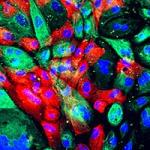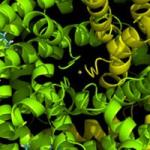
Research Topics
The cause of most heart attacks and strokes, atherosclerotic plaques in blood vessel walls accumulate cholesterol primarily from circulating low-density lipoproteins (LDL), also known as “bad cholesterol.” Dr. Kruth’s research focuses on understanding this process of cholesterol accumulation and plaque formation.
Scientists have known for some time that macrophages, a type of inflammatory cell, take up LDL to become foamy, cholesterol-laden cells within plaques. Dr. Kruth and his colleagues have demonstrated an alternative mechanism for macrophage foam cell formation that does not depend on LDL modification or macrophage receptors. By this mechanism, macrophages show uptake and degradation of native unmodified LDL by receptor-independent, fluid-phase pinocytosis. This produces cholesterol accumulation in macrophages to levels characteristic of macrophage foam cells in atherosclerotic plaques without requiring any modification of LDL to promote its cellular uptake. Even when LDL is aggregated, macrophages can disaggregate the LDL by a plasmin-mediated mechanism, and then take up this disaggregated LDL. Dr. Kruth’s laboratory has shown that macrophages in atherosclerotic plaques demonstrate fluid-phase uptake of fluorescent LDL-like surrogate nanoparticles, confirming this fluid-phase based mechanism of macrophage cholesterol accumulation can occur in plaques.
In addition to accumulating cholesterol, macrophages are also capable of excreting it. In earlier research, The Kruth lab demonstrated extracellular accumulation of cholesterol in its unesterified form in atherosclerotic plaques, then studied the possible sources of this cholesterol. Two possible sources discovered were from macrophage excretion of cholesterol in the absence of exogenously provided cholesterol acceptors. In one process, macrophages excreted cholesterol in the form of soluble ApoE-phospholipid-cholesterol discoidal particles. Additional investigation identified another mechanism for accumulation of extracellular cholesterol. In collaboration with colleagues, Dr. Kruth used a monoclonal antibody that specifically labels ordered arrays of unesterified cholesterol molecules to show that macrophages can shed insoluble amorphous phospholipid-cholesterol complexes into the extracellular matrix. This research has shown that ABCA1 protein (and additionally ABCG1 in the mouse) functions in macrophage deposition of this cholesterol into the extracellular matrix. These extracellular matrix-associated cholesterol deposits can be mobilized by HDL.
Learning how to mobilize cholesterol from intracellular and extracellular sites of accumulation within the vessel wall will be important to reversing the development of atherosclerotic plaques and their pathologic outcomes of heart attack and strokes.
Biography
Howard Kruth received his M.M.S. from Rutgers Medical School in 1973 and his M.D. from the University of Pennsylvania Medical School in 1975. He interned in the Department of Medicine at the University of Florida until 1976 when he joined the Laboratory of Cellular Metabolism at the NHLBI as a staff associate. Dr. Kruth returned to the University of Florida in 1978 for a residency in Clinical Pathology, and then came back to the NHLBI as Senior Investigator in the Laboratory of Experimental Atherosclerosis in 1980. In 1988, he became the head of the Experimental Atherosclerosis Section. Dr. Kruth has received both the Public Health Service Meritorious Service Medal in 1998 and Commendation Medal in 2004. He has authored or co-authored over 100 publications and serves on several international advisory boards.
Selected Publications
- Jin X, Dimitriadis EK, Liu Y, Combs CA, Chang J, Varsano N, Stempinski E, Flores R, Jackson SN, Muller L, Woods AS, Addadi L, Kruth HS. Macrophages Shed Excess Cholesterol in Unique Extracellular Structures Containing Cholesterol Microdomains. Arterioscler Thromb Vasc Biol. 2018;38(7):1504-1518.
- Kruth HS. Receptor-independent fluid-phase pinocytosis mechanisms for induction of foam cell formation with native low-density lipoprotein particles. Curr Opin Lipidol. 2011;22(5):386-93.
- Jin X, Freeman SR, Vaisman B, Liu Y, Chang J, Varsano N, Addadi L, Remaley A, Kruth HS. ABCA1 contributes to macrophage deposition of extracellular cholesterol. J Lipid Res. 2015;56(9):1720-6.
- Buono C, Anzinger JJ, Amar M, Kruth HS. Fluorescent pegylated nanoparticles demonstrate fluid-phase pinocytosis by macrophages in mouse atherosclerotic lesions. J Clin Invest. 2009;119(5):1373-81.
- Freeman SR, Jin X, Anzinger JJ, Xu Q, Purushothaman S, Fessler MB, Addadi L, Kruth HS. ABCG1-mediated generation of extracellular cholesterol microdomains. J Lipid Res. 2014;55(1):115-27.
Related Scientific Focus Areas


Molecular Biology and Biochemistry
View additional Principal Investigators in Molecular Biology and Biochemistry

This page was last updated on Tuesday, January 14, 2025